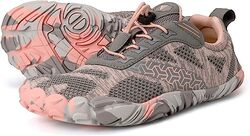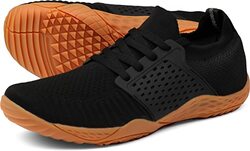Contents
Rowing is a great workout, whether you are using a rowing machine indoors, or rowing outdoors on the water. It provides a full-body workout because it is designed to engage every major muscle group. However, as with any type of exercise, the results you get from rowing depend on how you approach it.
There are three key contact points in rowing: your feet, butt, and your hands. Therefore, it is critical to ensure these areas have the proper protection to minimize the impact of the rowing motion, maximize comfort, and get the most out of rowing.
Both power and comfort are equally important when it comes to choosing the best rowing shoes. In fact, the shoes you wear while rowing can make a huge difference when it comes to rowing form, rowing injuries, and how much you get out of your rowing session.
Some people assume that running shoes work just as well for the rowing stroke, but that’s not the case, largely due to impact.
Rowing has a low impact on your legs while running has an immense impact on your legs. Therefore, running typically requires a great deal of shock absorption to help minimize the impact by cushioning your feet when they come into contact with the ground or pavement.
On the other hand, rowing does not require heavy cushioning. In fact, cushioned soles tend to hamper the rowing workout by altering the angle of the feet in relation to the rowing machine. This greatly reduces the power of your rowing stroke, and it might take longer to achieve your fitness and health goals.
In simple terms, if you are just looking for a basic exercise without any specific fitness or health goals in mind, running shoes may work for you. However, if you want to get the most out of your rowing workout, it is essential to take a closer look and understand what to look for in rowing shoes.
What should you look for in indoor rowing shoes?
Let’s explore all three in more detail.
1. Form and comfort
Correct form heavily relies on your foot placement. This means that incorrect foot placement can easily lead to bad form. If you place your feet too high on the footrests, your stroke will be shorter, while low foot placement reduces power and weakens your leg drive. Moreover, it puts extra stress on your spine and back muscles, making for a rather uncomfortable rowing workout.
In addition to foot placement, having shoes with a large heel-to-toe drop (much thinner at the toe than it is at the heel) can impact your form by altering the angle of your feet. Ideally, your feet should be at a 45º angle when they are properly placed at the footrests. A larger heel-to-toe drop decreases that angle, and that can lead to discomfort and improper form.
Keep in mind that comfort is not just about foot placement, there are other factors to take into consideration when choosing rowing shoes. Ideally, they should allow for breath-ability and flexibility so you can exercise without developing blisters and other injuries from friction and sweat.
It is also important for your rowing shoes to allow you to comfortably feel the foot-board to ensure that you are using the right part of your feet during the drive phase. This is the main reason why many people wear flat shoes or choose to row barefoot. While rowing barefoot is not for everyone, you can wear minimalist shoes to achieve the same natural feel while still ensuring that your feet are protected from friction and sweat-related injuries.
2. Correct foot placement
In order to get the most out of rowing, you must ensure that you have mastered the proper rowing stroke, and that starts with foot placement. If the placement of your feet is wrong, it can prevent you from putting adequate power behind your rowing stroke or completing a full rowing stroke.
If you place your feet too high on the footrests, you’ll be unable to move forward to a position where your shins are vertical, which is key to completing a full rowing stroke. On the other hand, placing your feet too low means that your drive will be insufficient, affecting other essential parts of your overall rowing form.
Your foot placement can be affected by the type of shoes you wear, If your shoes have a lot of cushioning, you may find it difficult to place your feet high enough.
3. Efficiency and power
Correct form and proper foot placement are critical for a more efficient rowing stroke and maximum power. Moreover, wearing the wrong type of rowing shoes reduces the amount of power in your rowing stroke. For instance, using running shoes with large, soft soles reduces the total amount of force generated during the drive phase, making it less efficient.
Using proper rowing shoes ensures that power is transmitted from your legs more efficiently, and shoes with rigid soles can help counter this effect.
The best shoes for erging:
It’s clear that the type of rowing shoes you wear can have a huge impact on your workout. So, what type of rowing shoes should you consider? There are many different types of rowing shoes on the market, and the final choice usually boils down to personal preference.
1. Minimalist training shoes
When it comes to finding the perfect footwear for your indoor rowing sessions, minimalist training shoes can be a game-changer. They offer a unique blend of comfort, flexibility, and support, allowing you to make the most out of your rowing workouts while keeping your feet happy.
So, what exactly makes minimalist training shoes so special for indoor rowing?
Well, let’s break it down. Firstly, they’re designed to provide a barefoot-like experience, giving you a natural feel and allowing your feet to move and flex more freely. This is crucial in rowing as it helps you maintain proper form and engage all the muscles in your feet and lower legs.
Minimalist or barefoot shoes also tend to have a lower heel-to-toe drop, which means that the height difference between the heel and the toe is minimal. This promotes a more neutral foot position and helps you maintain a solid connection with the footplates on your rowing machine. It enhances stability and power transfer, allowing you to generate maximum force with each stroke.
Another great feature of this type of training shoe is the lightweight construction. They’re designed to be as light as possible, reducing unnecessary bulk and allowing for quicker foot movements. This is particularly advantageous during intense rowing sessions when every split second counts.
![]()
Now, while minimalist shoes offer numerous benefits, it’s important to note that they may not be suitable for everyone. Remember, finding the right pair of indoor rowing shoes is a personal journey.
What works for one person might not work for another, so take the time to try on different models and brands to find the perfect fit for your feet. Don’t be afraid to ask for recommendations from fellow rowers or fitness experts who may have already explored the world of minimalist footwear.
2. Flat soles
These are shoes with zero heel-to-toe drop, making them entirely flat, just as the name suggests. They have very thin and flexible soles, giving you maximum feel on the foot-board. In addition to helping enhance your stroke, they are fairly common and can be easily found at reasonable prices. This makes them a great choice, especially if you don’t want to spend a lot.
Check out flat sole shoes for WOMEN here!
3. Sport-specific
These shoes are specially designed for a specific purpose, such as wrestling, soccer, or skateboarding, which may also work for rowing. Although there are sport specific shoes designed with the needs of rowing enthusiasts in mind, they are usually more expensive and harder to find.
Conclusion
You can always start rowing in whatever shoes you are currently wearing. However, there are reasons why serious athletes use specific gear, including shoes and gloves. Wearing the right gear helps enhance your performance while minimizing injury and fatigue, which maximizes the effectiveness of your exercise
Therefore, if you are considering adding rowing to your workout routine, whether indoors on your rowing machine or outdoors in nature, you may want to invest in extras like shoes and gloves that can make a huge difference.



